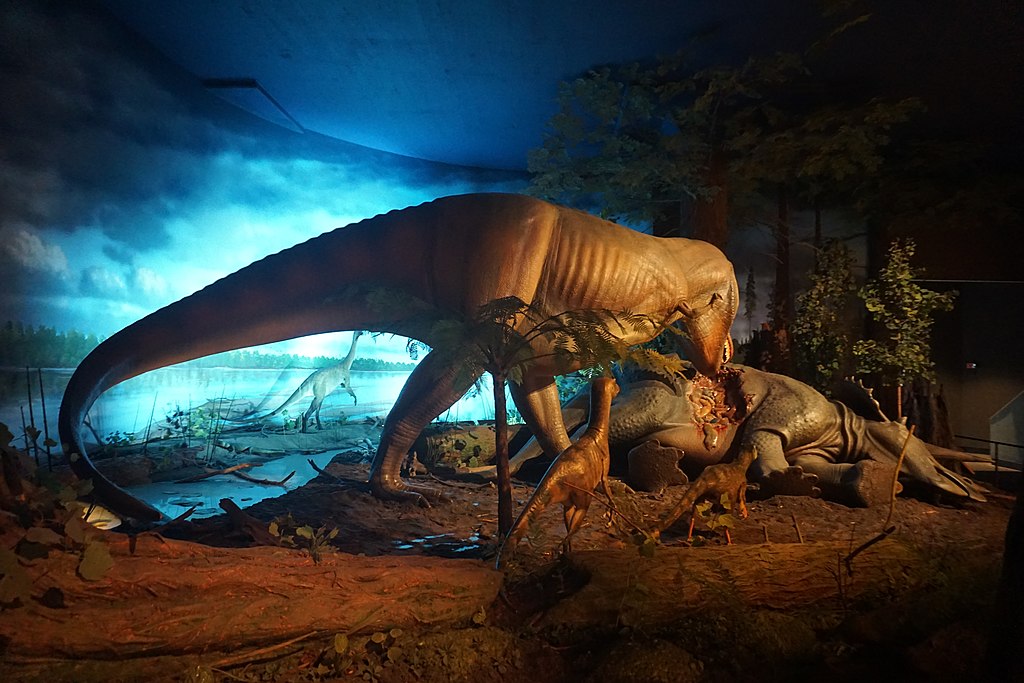Tyrannosaurus rex: Apex Predator of the Late Cretaceous
Introduction
Tyrannosaurus rex, often referred to as T. rex, is one of the most iconic and extensively studied dinosaurs in paleontology. This formidable predator lived approximately 68 to 66 million years ago during the Late Cretaceous period. Known for its massive size, powerful jaws, and sharp teeth, T. rex has captivated scientists and enthusiasts alike, symbolizing the might of prehistoric life.
Physical Characteristics
Tyrannosaurus rex was a colossal theropod dinosaur, reaching lengths of up to 40 feet and standing about 12 feet tall at the hips. It weighed between 7 and 10 tons, making it one of the largest carnivorous dinosaurs. Its skull was over five feet long, housing 50 to 60 thick, serrated teeth designed for crushing bone and tearing flesh. Despite having small, seemingly underdeveloped arms, T. rex possessed immense strength in its legs, allowing it to move at estimated speeds of up to 12 to 20 miles per hour. Its keen senses, particularly vision and smell, made it a highly effective hunter.
Natural History and Discovery
The first fossilized remains of T. rex were discovered in 1902 by paleontologist Barnum Brown in Montana, USA. Officially named in 1905 by Henry Fairfield Osborn, the name Tyrannosaurus rex means “tyrant lizard king.” Since its discovery, numerous specimens have been unearthed across western North America, from Canada to New Mexico. These fossils have provided invaluable insights into its anatomy, growth, and behavior, establishing T. rex as a subject of continuous scientific inquiry.
Biosphere and Habitat
T. rex thrived in a warm, humid environment with lush vegetation during the Maastrichtian age of the Late Cretaceous. The landscape consisted of dense forests, open plains, and river valleys. This region, known as Laramidia, was a vast island continent created by high sea levels that split North America into two landmasses. The diversity of flora included ferns, cycads, conifers, and angiosperms, which supported a variety of herbivorous dinosaurs and other wildlife.
Diet and Hunting Behavior
As an apex predator, T. rex had a carnivorous diet that likely included both live prey and scavenged carrion. It preyed upon large herbivorous dinosaurs like Triceratops and Edmontosaurus, using its immense bite force, estimated at over 12,000 pounds per square inch, to crush bones and consume entire carcasses. Evidence suggests that T. rex might have been a solitary hunter, although some theories propose limited social behavior. Fossilized tooth marks and healed injuries in prey animals indicate that it engaged in direct predation.

Coexistence with Other Animals
T. rex shared its ecosystem with a variety of dinosaurs and other creatures. Among its contemporaries were ceratopsians like Triceratops, hadrosaurs such as Edmontosaurus, armored ankylosaurs, and smaller theropods like Dromaeosaurus. Non-dinosaurian fauna included pterosaurs, crocodilians, turtles, and an array of mammals and early birds. These animals formed a complex food web that supported both herbivores and carnivores in a dynamic Late Cretaceous ecosystem.
Conclusion
Tyrannosaurus rex remains a symbol of prehistoric power and adaptability. Its dominance in the Late Cretaceous biosphere, coupled with its impressive physical traits and ecological role, underscores its significance in the natural history of Earth. Continued research and new fossil discoveries promise to reveal even more about this legendary predator, ensuring its place as a cornerstone of paleontological studies.
Featured image credit:
Nobu Tamura
Editor’s Note:
I use Open AI’s Chat GPT to write Species Profiles. Read more about this and get a copy of the prompt I’ve created here.
editor's pick
latest video
news via inbox
Nulla turp dis cursus. Integer liberos euismod pretium faucibua








